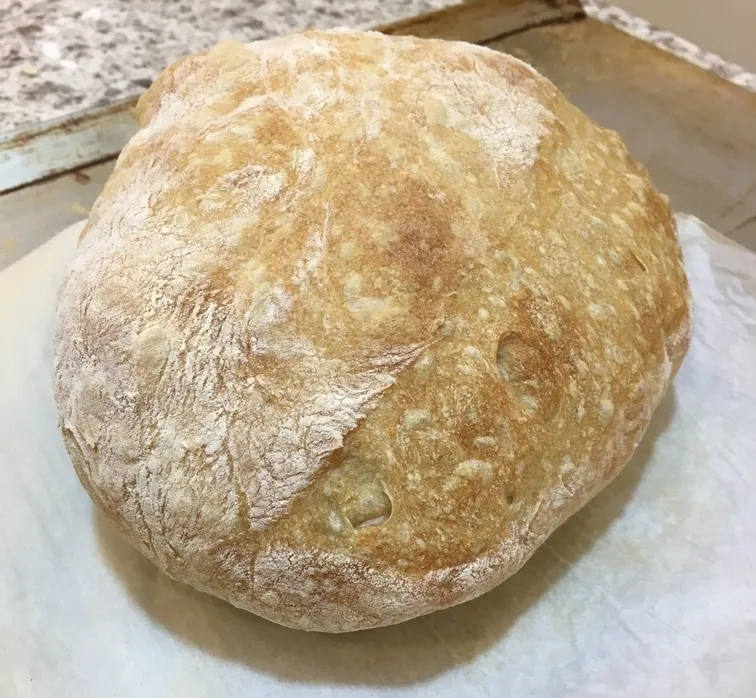
This is just an 80% hydration plain flour-salt-yeast-water recipe.
I've struggled with the mixing and kneading technique for this for years. I do not own a stand mixer and kneaded this by hand. The ingredients make this style of bread seem easy, but it's actually detailed work to get the airy crumb you want.
The last time I tried this, I wound up with a very flat Ciabatta.
I view working the dough as having three stages, with rest & rise periods in between each.
- Mixing with a tempered glass stir rod for 10-12 minutes. This is the toughest work but you just do it once.
- Kneading, where you wet your hands and use the slap-and-fold technique in the bowl. This is relatively gentle compared to the mixing, but you do it several times with hour-long rises in between.
- Shaping, where you sprinkle flour on a work surface and on your dry hands, then perform just 1-2 folds before pinching the doughball shut. This is again even more gentle than the previous two types of steps, but you just do it at the end before preheating the oven.
- Between mixing and wet kneading, I just let the dough sit in the bowl to autolyse.
- Between wet kneading steps (I did 2), I let the dough rise in the bowl.
- Between kneading and shaping, I *carefully* roll the delicate doughball onto a floured parchment sheet.
- After shaping, I gently tuck the dough under itself in order to prop it up for its final rise.
- I score the dough as a final step in dry kneading.
Tip: to get more spring, say if you are baking at a temperature like 425F, stick the doughball in the oven before it is fully preheated, say at around 340F. This allows the yeast to spend just a little extra time in their final gas-production phase, giving you larger bubbles.
Tip: During final shaping, sprinkle flour to the top side of the loaf. Let it sit for about 20 minutes in the open air between doing this and sticking in the oven. This dries out the top surface of the doughball considerably and makes it more stiff when it goes in. If the top is stiff, it will stretch less than the sides and this will result in upward, vertical spring rather than outward or horizontal spring.
Tip: Make less than you think you need. I am used to thinking that 400g is a half-sized sandwich loaf, but this bread is so airy that 360g will make a full-sized loaf. (The boule pictured was made with 360g flour).
Previous attempts failed because:
- I did not know how to control the dough in the kneading stage, which I now think of as the wet kneading stage. I tended to use dry hands, rubber spoons, and other implements to which the dough would stick. Just wet your hands and start folding it.
- If you have not mixed/kneaded enough (ie because it is too sticky), the water in the dough will not be bound into the hydrated gluten, this will leave the dough sticky and dense.
- I was too rough with the dough while transferring it between kneading and shaping steps, resulting in misshapen and flat loaves.
So glad that this finally worked! The crumb is still not pro-bakery perfect but this is leagues ahead of where I was before. Now I just have to avoid stuffing myself. Good day!
Do you have a crumb shot?
I got more pocket formation near the top. When I was shaping, I was worried that it was sagging too much and "tucked" some of the sides under the loaf. I think this is why the crumb is a bit denser there. I think if I just cross my fingers and trust that it will rise next time, I'll actually get a more airy result.
Not bad at all! Looks yummy!
I've been experimenting for the first time with high hydration doughs myself, with improvements after every bake.
I am so glad you've written this down. I noticed with bake 5 this weekend that I repeated the mistake from bake 1, and was saved only by the experience from the later bakes.
Keep up the good work.
thats really cool, im definitely going to try powdering it with flour at the end drying out the crust, that has got to make the crust cook thinner! But maybe it has to go in the oven slightly lower in temperature to get that to work?
Im definitely going to try this NEXT step!
And ur sound like your being very careful with your risen dough, Im not sure whether to do that, or to kneed it more to develop the elasticity... or actually i need it less and just mix it properly first, like u said?
Thanks for the vid, very promising results lots of potential,. glad to see some-one taking it this seriously! awesome.